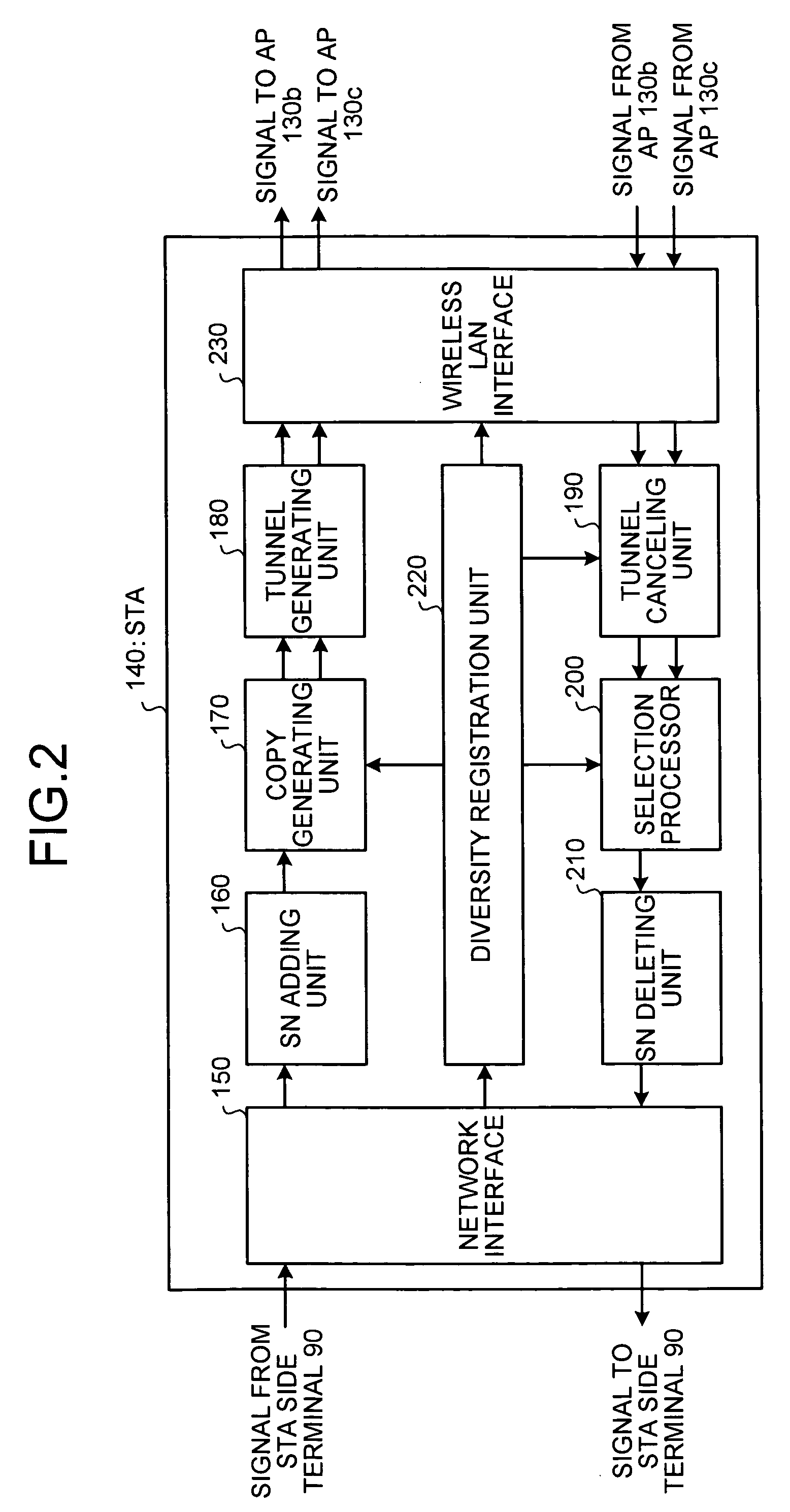Radio LAN system, diversity apparatus, and radio LAN terminal
a radio lan and diversity technology, applied in the field of wireless lan systems, can solve the problems of long transmission distance, inability to realize high-speed transmission in long-distance communication, and deterioration of wireless networks, so as to reduce the time of temporary disconnection at the time of handover, the effect of low error ra
- Summary
- Abstract
- Description
- Claims
- Application Information
AI Technical Summary
Benefits of technology
Problems solved by technology
Method used
Image
Examples
first embodiment
[0017]the present invention will be explained with reference to FIGS. 1 to 4. FIG. 1 is a system configuration of a wireless LAN system according to the present invention. In the wireless LAN system shown in FIG. 1, a plurality (in this case, five) of wireless LAN base stations (hereinafter, “AP”) 130a to 130e, a diversity device 120, and a terminal device 110 (hereinafter, “network terminal”) are connected to an IP network 100. The network terminal 110 is a fixed terminal, such as a web server.
[0018]A wireless LAN terminal (hereinafter, “STA”) 140 is wirelessly connected to the APs 130a to 130e. The STA 140 is a wireless transmitter receiver forming the wireless LAN together with the APs 130a to 130e, and under supervision of the STA 140, one or a plurality of user terminal devices 90, such as personal computers, are connected to the STA 140 via a cable, for example. The STA 140 and the user terminal devices 90 move in a unified manner. In this case, a wide area wireless LAN is ass...
second embodiment
[0065]In a second embodiment, for each sequence number, the selection processor 200 in the STA 140 shown in FIG. 2 performs the selection process in which a first correctly received packet, of a plurality of downlink packets having the same sequence number, is determined as a selected packet, and sent out to the SN deleting unit 210, and all the packets having the same sequence number received thereafter are disposed of.
[0066]The selection processor 400 in the diversity device 120 shown in FIG. 3 performs the similar process. That is, for each sequence number, the selection processor 400 performs the selection process in which a first correctly received packet, of a plurality of uplink packets having the same sequence number, is determined as a selected packet, and sent out to the SN deleting unit 410, and all the packets having the same sequence number received thereafter are disposed of.
[0067]According to such selection process, a packet delay is reduced, and the circuit configura...
third embodiment
[0068]In a third embodiment, the selection processor 200 in the STA 140 shown in FIG. 2 waits for a certain period of time to receive a plurality of downlink packets having the same sequence number, and selects one packet among the one or more packets having the same sequence number received within the certain period of time. In other words, the selection processor 200 saves a first correctly received packet temporarily, waits until the certain period of time has passed, and performs selection process to select one packet out of the packets received within the certain period of time.
[0069]The selection processor 400 in the diversity device 120 shown in FIG. 3 performs the similar process. That is, the selection processor 400 waits for a certain period of time to receive a plurality of uplink packets having the same sequence number, and selects one packet among the one or more packets having the same sequence number received within the certain period of time.
[0070]According to such s...
PUM
 Login to View More
Login to View More Abstract
Description
Claims
Application Information
 Login to View More
Login to View More - R&D
- Intellectual Property
- Life Sciences
- Materials
- Tech Scout
- Unparalleled Data Quality
- Higher Quality Content
- 60% Fewer Hallucinations
Browse by: Latest US Patents, China's latest patents, Technical Efficacy Thesaurus, Application Domain, Technology Topic, Popular Technical Reports.
© 2025 PatSnap. All rights reserved.Legal|Privacy policy|Modern Slavery Act Transparency Statement|Sitemap|About US| Contact US: help@patsnap.com



